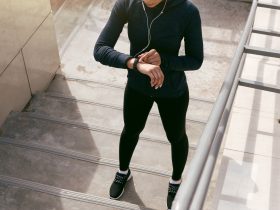If you want to focus on lower-body strength, incorporating a kettlebell legs workout into your weekly routine is highly effective, it doesn’t require a multitude of exercises, and will help improve overall fitness.
Emphasize squat and hinge movements, such as kettlebell squats and hip hinges, to target major muscle groups effectively.
Include both bilateral (using both legs) and unilateral (single-leg) movements like lunges. This variety challenges your body differently, enhancing overall strength and addressing muscle imbalances.
Kettlebells engage muscles uniquely due to their shape, offering advantages over traditional dumbbells. This workout focuses on four core movements that effectively target quads, hamstrings, adductors, abductors, calves, and glutes.
Consistently performing these exercises and gradually increasing resistance or repetitions ensures progressive overload. This approach is essential for continuous muscle adaptation and strength gains.
Choosing a workout routine that challenges and motivates you is crucial for long-term adherence and success. This kettlebell legs workout is designed to be engaging and effective, supporting your fitness journey with each session.
The Workout
Equipment Needed
For this workout, you’ll require two medium-to-heavy kettlebells. The appropriate weight will vary based on your fitness level and experience.
It’s recommended to choose a weight that challenges you, where the last two to three repetitions of each exercise feel demanding but still manageable with proper form. Throughout the workout, assess your performance after each set.
If you find the weight too light (you could have done five more reps), consider increasing it for subsequent sets. Conversely, if the weight feels too heavy (you can barely manage five reps), opt for a lighter kettlebell to maintain form and prevent injury.
Exercises
- Front Squat – Targets quadriceps, glutes, and hamstrings, and helps enhance core stability.
- Suitcase Split Squat – Targets quadriceps, glutes, and hip stabilizers.
- Single-Leg Deadlift – Targets hamstrings, glutes, lower back, and core stability.
- Lateral Lunge – Targets quadriceps, glutes, and adductors.
Directions
- Perform 8–10 repetitions of each exercise, ensuring proper form throughout.
- Rest for 1 to 2 minutes between sets to allow for adequate recovery.
- Complete 3 to 4 rounds in total for a comprehensive workout session.
- After completing all sets of one exercise, move on to the next exercise in the sequence.
This structured kettlebell workout targets multiple muscle groups while emphasizing proper technique and progressive overload. Adjusting kettlebell weight based on your performance ensures optimal challenge and effectiveness in achieving your fitness goals.
- Front Squat
Setup: Begin by standing with your feet shoulder-width apart, toes slightly turned out. Hold a kettlebell in each hand at your shoulders, using an overhand grip with palms facing inward. Ensure the bells are positioned in front of your shoulders, maintaining a firm grip on the handles.
Execution:
- Engage Core and Posture: Prioritize core engagement and maintain a lifted chest with a flat back throughout the movement.
- Lowering Phase: Shift your weight back onto your heels as you push your hips back and bend your knees, gradually descending into a squat position. Aim to lower until your thighs are parallel to the ground, ensuring your knees track in line with your toes.
- Driving Up: Push through your heels to stand up, simultaneously squeezing your glutes at the top of the movement. This completes one repetition.
Muscles Targeted: The front squat is a comprehensive lower body exercise engaging quadriceps, hamstrings, glutes, and core muscles. Holding the kettlebells in the front-racked position also activates upper body muscles including lats, traps, and rhomboids in the upper back.
Technique Tips:
- Maintain a strong chest position throughout to counterbalance the weight and prevent forward leaning.
- Focus on driving through the heels during the ascent to maximize glute activation.
- Keep knees aligned with toes to ensure safe and effective movement mechanics.
Additional Notes
- Performing front squats not only strengthens lower body muscles but also enhances upper body stability and core strength due to the front-racked kettlebell position.
- Ensure smooth and controlled movement throughout the exercise to optimize muscle engagement and reduce the risk of injury.
Incorporating front squats into your workout routine promotes overall strength development while emphasizing proper form and muscular balance across the body.
- Suitcase Split Squat
Setup: Begin by holding a kettlebell in your left hand, allowing it to hang down by your side. Stand with your feet hip-width apart, ensuring a stable base of support.
Step your right foot forward into a position similar to a forward lunge, keeping your left heel firmly planted on the ground. This stance establishes your starting position.
Execution:
- Lowering Phase: Bend both knees to lower your body towards the ground, aiming to create 90-degree angles at both your front and back legs. Simultaneously, hinge slightly forward at the hips while maintaining a flat back and engaged core. Ensure your front knee stays aligned with your ankle to prevent excessive strain.
- Engagement: Throughout the movement, focus on engaging your core muscles to stabilize your torso and prevent any arching or rounding of your back. Your front thigh should ideally become parallel to the floor, while maintaining tension in your glutes and core.
- Ascending Phase: Push through your front foot to return to the starting position, emphasizing the use of your quadriceps and glutes to propel yourself upward. This completes one repetition.
Muscles Targeted: The Suitcase Split Squat is a dynamic lower body exercise that effectively targets multiple muscle groups including quadriceps, glutes, hamstrings, spinal erectors (lower back), adductors (inner thigh), and core. Holding the kettlebell down by your side also engages forearm muscles to maintain grip and stability.
Technique Tips:
- Keep your torso upright and avoid leaning excessively forward or backward throughout the exercise.
- Maintain a controlled descent and ascent to maximize muscle engagement and minimize the risk of injury.
- Focus on distributing your weight evenly between your front and back legs to ensure balanced muscle activation.
Additional Benefits:
- Incorporating the Suitcase Split Squat into your workout routine enhances lower body strength, stability, and coordination.
- The unilateral nature of the exercise helps to address muscular imbalances and improve overall functional fitness.
- By engaging the core and stabilizing muscles, this exercise promotes enhanced posture and body control during everyday activities.
- Single-Leg Deadlift
Setup: Begin by standing with your feet together, holding a kettlebell in your right hand in front of your right leg. This initial position sets the foundation for the exercise.
Execution:
- Weight Shift and Hinge: Transfer your body weight onto your left leg. Maintain a slight bend in your left knee while keeping your back flat and core engaged. Hinge forward at the hips, simultaneously pushing your buttocks back. Extend your right leg straight behind your body as you lower the kettlebell towards the floor. Focus on feeling a stretch in your left hamstring during this phase.
- Core Engagement: Keep your core muscles tight throughout the movement to stabilize your torso. As you hinge forward, maintain control and ensure the kettlebell stays close to your body to avoid losing balance.
- Ascending Phase: Drive through your left heel to return to the standing position. Simultaneously, pull the kettlebell back up to the starting position while squeezing your glutes at the top of the movement. Allow your right leg to lightly tap the floor behind you without bearing weight, completing one repetition.
Muscles Targeted: The Single-Leg Deadlift targets several muscle groups including hamstrings, glutes, erector spinae (lower back), traps, and forearm muscles due to the grip required to hold the kettlebell. The unilateral nature of the exercise also engages core muscles, particularly the obliques, for stabilization and balance.
Technique Tips:
- Maintain a flat back and avoid rounding your shoulders throughout the movement.
- Focus on evenly driving your hips back as you hinge forward, ensuring both sides of your body engage equally.
- Keep the kettlebell close to your body’s centerline to maintain stability and control.
Additional Considerations:
- As a single-leg exercise, the Single-Leg Deadlift improves balance, coordination, and proprioception.
- Beginners may benefit from lightly supporting themselves with a chair or countertop for added stability until they develop sufficient strength and balance.
- Gradually increase the weight of the kettlebell as you become more comfortable with the movement and aim to perform each repetition with controlled form.
- Lateral Lunge
Setup: Start by standing with your feet hip-width apart, holding a kettlebell by the handle with both hands positioned at your chest. This initial stance establishes the starting position for the exercise.
Execution:
- Lateral Movement: Begin by taking a large step out to your right side. As you do so, maintain control and ensure your core remains engaged throughout the movement.
- Lowering Phase: Bend your right knee and hinge forward at the hips, simultaneously sitting your buttocks back to descend into a lateral lunge. Focus on keeping your back flat and preventing your knee from extending beyond your toes to maintain proper form and reduce stress on your joints.
- Driving Up: Push through your right heel to return to the starting position, utilizing your quadriceps, glutes, and hamstrings to power the movement. This completes one repetition.
Repetition and Alternation:
- Perform 8-10 repetitions with your right leg, maintaining controlled movements and focusing on muscle engagement.
- Once completed, switch sides and repeat the exercise for 8-10 repetitions with your left leg to ensure balanced development and muscle activation.
Muscles Targeted: The Lateral Lunge effectively targets multiple muscle groups including quadriceps, glutes, hamstrings, lower back, inner thigh (adductors), and core muscles. This exercise promotes strength and stability in the lower body while enhancing flexibility and range of motion.
Technique Tips:
- Maintain a flat back and engage your core to stabilize your torso throughout the movement.
- As you lunge to the side, focus on keeping your trailing leg straight to maximize the stretch in your inner thigh and enhance the effectiveness of the exercise.
- Ensure your knee remains aligned with your toes during the descent to prevent potential strain and maintain joint integrity.
Additional Benefits:
- The Lateral Lunge improves lateral movement capabilities, which is beneficial for sports-specific agility and daily activities that require side-to-side motion.
- By incorporating this exercise into your routine, you enhance overall lower body strength, balance, and coordination.
- Focus on controlled movements and gradual progression to optimize muscle development and functional fitness.
Key Takeaways
Incorporating kettlebell workouts focused on lower-body strength offers a versatile and effective approach to enhancing overall fitness. By emphasizing fundamental movements such as squats, hinges, lunges, and lateral movements, this workout targets major muscle groups including quads, hamstrings, glutes, and core stabilizers.
Consistency and progressive overload are key principles for maximizing strength gains and addressing muscle imbalances effectively.
Whether you’re new to kettlebells or seeking to diversify your fitness routine, this structured workout provides a balanced combination of exercises that can be tailored to various fitness levels. Remember to choose kettlebell weights that challenge you appropriately and prioritize proper technique to ensure safe and effective workouts.
With commitment and dedication, integrating these kettlebell exercises into your routine supports long-term fitness goals and enhances overall lower-body strength and functionality.
















Find Us on Socials